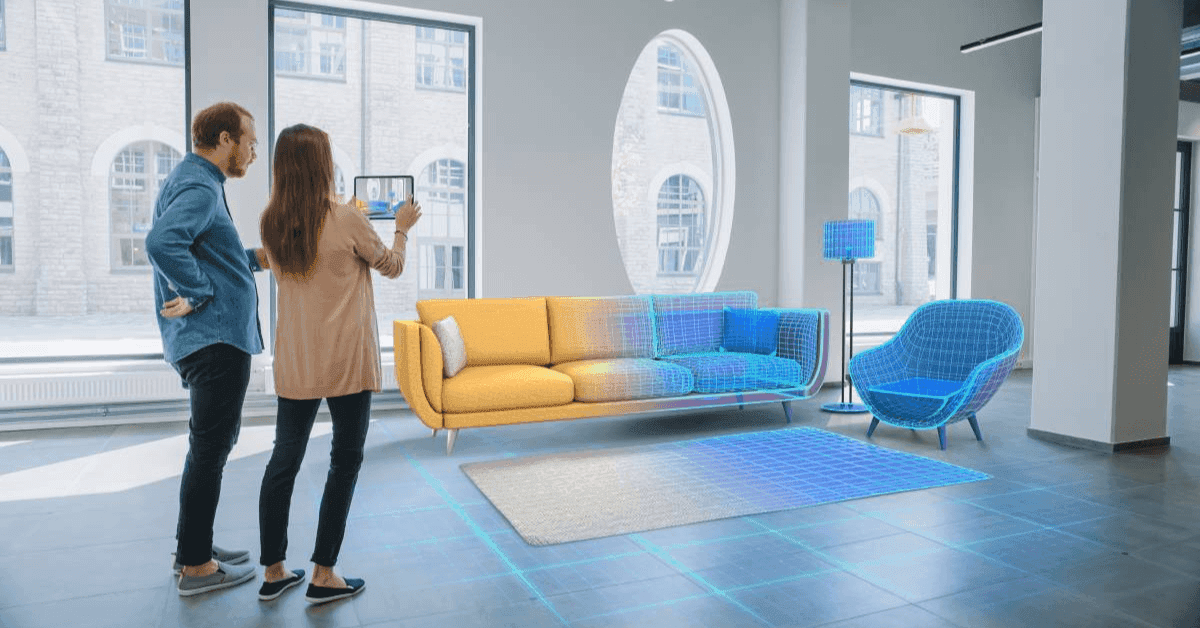Every one of us has encountered augmented reality at some point or another. Be it when playing a game of Pokemon Go, having fun by taking photos while using those crazy Snapchat filters, furnishing our houses using the IKEA app, or even while experimenting with various beauty products using the L'Oreal app.
Augmented reality is that! Being able to engage with something you can see and manipulate that isn't actually there while yet being in the real world. In augmented reality (AR), real and virtual components are combined. It is a technique that works well on both desktops and mobile devices. The ability to mirror digital elements in the physical environment is what distinguishes it as unique. So, what is AR actually? Simply said, augmented reality is a technology that adds layers of digital components to the actual environment to make it more appealing. These components might include haptic feedback, computer-generated visuals, sound or video effects, or sensory projects.
The goal of augmented reality is to make the environment you currently see much cooler, as opposed to the total immersion of virtual reality. Digital data is placed over the real environment to create augmented reality. Your camera recognises a target picture and uses sensors to determine the target image's distance and angle from the camera. Then, it overlays digital data on that target image to create augmented reality.
The actual and virtual worlds are brought together by augmented reality to provide people an experience that is more powerful and engaging. The most popular types of augmented reality (AR) include inserting data into a real-world environment using a camera lens or a pair of smart glasses. The cutting-edge technologies we use to access augmented reality are evolving along with the interest in augmented reality technology. More sophisticated hardware and lenses are becoming available on the market.
However, the most important elements of AR may be:
Sensors: In order to match the actual and virtual landscapes, AR systems must be able to swiftly and accurately gather data from the outside world. For this, we have sensors and cameras. When a camera or sensor gathers data, it transmits it to an app or piece of software to be processed.
Software for augmented reality: We access augmented reality (AR) through applications and other technologies. Due to the popularity of Google ARCore and Apple's ARKit, it's now much simpler for anyone to develop their own augmented reality applications. may also assist in processing data for your augmented reality application.
Processing: In order for AR to function, there must be processing power. This entails utilising the capabilities of the operating system of the phone for an AR app on a smartphone. Most smart glasses require a small computing system of their own.
Lenses and viewing: To see the digital material in the real environment using AR glasses or smartphone applications, you need a lens or image platform. The material seems more realistically the higher the screen quality.
Artificial intelligence: For most AR systems to function successfully, some part of AI is used. AI can complement augmented reality by enabling users to carry out tasks using their voice (natural language processing). Information processing for your AR application can also be aided by AI.
Some of the earliest uses of augmented reality were the head-up displays on fighter jets, allowing pilots to see important information projected in front of them on their windshields. This technology eventually made its way to automobiles, and even your eye glasses with Google Glass. There are many apps you can download right now that utilize augmented reality. Yelp, for instance, has a feature called Monocle that let’s you see restaurant reviews and information around you. The SnapShop Showroom app uses augmented reality to show you how furniture will look in your room before you buy.
The rise of increased reality within the previous few years has sparked the invention of various “types” of augmentation. as an example, there’s “markerless” AR, that uses GPS systems, compasses, and gyroscopes to produce period info supported location. Companies may also produce AR experiences triggered by specific markers, like QR codes you'll be able to scan together with your smartphone. Experimentation within the AR house has additionally paved the thanks to ideas like “Projection-based” AR, that extends into the realm of mixed reality and holograms. When the majority see the “types” of AR accessible these days, they’re usually talking concerning the AR apps we are able to expertise through our phones, and therefore the slightly additional immersive experiences offered by wearables. Experts believe wearable devices and good glasses might be crucial to the long run success of AR technology. Facebook is one in all the market leaders during this setting right, finance in new ways to form AI-assisted, AR-enabled glasses a thought reality.
It's hard to predict with absolute certainty what the future of AR will include, as is the case with most revolutionary technology. Following the lead of pioneers like Facebook, it appears that more businesses will invest in augmented reality smart glasses and wearables.
Several sectors are seeing an increase in demand for AR wearables, especially those with risky work conditions like manufacturing and engineering.
AR avatars and other virtual creations are expected to grow increasingly prevalent as we continue to create more digital versions of ourselves and learn more about the metaverse. In the future, more individuals could produce their own augmented reality (AR) materials and surroundings to share.
The development of 5G may even open the door for a time when first responders might employ augmented reality (AR) glasses to more efficiently identify threats in difficult situations.
In other places, specialised technology meant to boost the effectiveness of AR solutions is still developing. Leading AR inventors, for instance, are already enhancing the AR capabilities of a variety of high-end mobile devices using LiDAR technology.
In the age of smartphones, this technology will increase the accessibility of AR apps for everyone!

POST A COMMENT (0)
All Comments (0)
Replies (0)